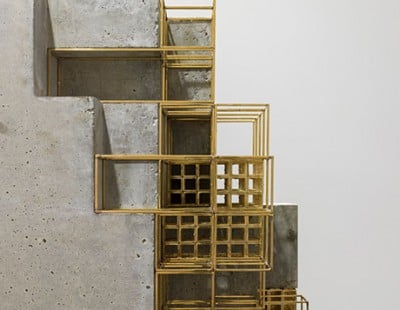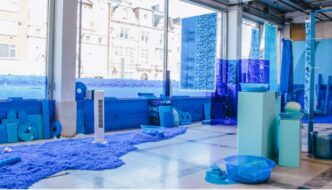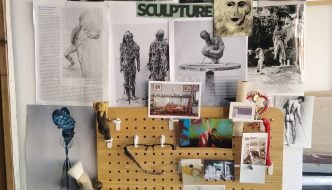Carol Bove / Carlo Scarpa Sculpture at The Henry Moore Institute
April 26, 2015

All images © The Henry Moore Institute 2015
The Henry Moore Institute, located on the Headrow in Leeds city centre is well acclaimed for its sculpture shows and experimental and varying programme of events. The currently exhibited ‘Carol Bove / Carlo Scarpa’ exhibition is certainly no exception. It represents a unique and engaging sculptural viewing experience, in which the pieces are given the display space that they deserve and the spectator is given free room to move around and interact with them.

The Henry Moore Institute is a centre for the study of sculpture and artistic form. It is renowned for its established teaching and educational centres and promotion of the arts, more generally. It has numerous gallery spaces used to display international sculptural exhibitions, both contemporary and historical by both British and International artists.
‘Carol Bova / Carlo Scarpa’, is displayed in three of the institutes large gallery spaces. The works are given a sizeable display space that brings together sculptures created between 2003 and 2014 by American artist Carol Bove (B. 1971) alongside rarely seen exhibition pieces and architectural prototypes by Venetian artist / architect Carlo Scarpa (1906 – 1978). Although of different disciplines and generations, the combination of the two artist’s work displays well together and makes for distinctive and stimulating viewing. The works compliment one another well, as do the rooms in which they are situated. The architecture of the Henry Moore itself produces an interesting gallery experience in which the conjoining rooms can be seen from inside one another. One can peer into the coming rooms so see what lies ahead, this offers an inviting and unique spectator experience where the works are layered and transitioned by the existing architecture of the building. These impressive pieces work in combination with each other, and the rooms in which they are situated.
 Bove and Scarpa’s work hold similar concepts at their centre – firstly, their work is bound by concerns with the object and its environment – the ways in which one interacts with sculptural arrangements and the way in which the spectator perceives their (the sculpture’s) meaning. How does the sculptor take artistic form, and at what point does the viewer perceive it as a sculpture? More broadly speaking, what is the nature of this encounter? All the pieces on display present questions on the display of artistic form, and the reimagining of material and organic matter.
Bove and Scarpa’s work hold similar concepts at their centre – firstly, their work is bound by concerns with the object and its environment – the ways in which one interacts with sculptural arrangements and the way in which the spectator perceives their (the sculpture’s) meaning. How does the sculptor take artistic form, and at what point does the viewer perceive it as a sculpture? More broadly speaking, what is the nature of this encounter? All the pieces on display present questions on the display of artistic form, and the reimagining of material and organic matter.
Bove’s work, in particular, explores how the arrangement or composition of (a) sculpture communicates the past life of the materials that comprise it. Her sculptural work often arranges natural specimens, feathers, wood, coral and shells etc. But her work can also be seen to include the ‘non-natural’ such as books and photographs. In either case her unique arrangements bring together items resulting in the creation of a fresh form, giving new meaning to the objects, which blur their original identities. The ‘seemingly worthless’ items are placed together by Bove to be given a new meaningful form in the arrangement of artistic experimentation. Through viewing this work one is able to re-perceive objects in this new form resulting in their unique totality.

The pieces on display here are impressive and experimental, Bove and Scarpa play with the idea of sculptural / architectural form – reimagining materials in new and exiting ways. The materials are hung on wires and stands, by Bove in some pieces. (As seen in ‘Heraclitus’ (detail) 2014’). This arrangement, as such, presents an interesting question of whether the stand is part of the sculpture or merely support. An answer to this question is not given in the exhibition, but again plays in to the questioning of the arrangement of sculptural form, a question which is repeated at various points throughout the display. The accompanying literature produced with the exhibition goes some way to address this issue on the ambiguous question of sculpture and support by suggesting, ‘while some are sculptures by Bove, others are resolutely exhibition furniture.’ In many ways the role of the spectator, alongside, the role / formation of sculpture is sophisticatedly and continually questioned in this display.
This exhibition is not to be missed; the pairing of Bove and Scarpa is both exciting and stimulating and offers an opportunity to see works rarely exhibited in the United Kingdom. This is a large-scale display in which the combination of the two artist’s work shows a presentation of their similar concerns with the encounter, sculpture and materials. The use and treatment of materials, in this exhibition, is distinctive and engaging while the scale and the size of the pieces gives them an impressive presence.
Accompanying exhibitions by similar artists are displayed alongside to compliment this exhibition in the conjoining galleries throughout the year. Please see The Henry Moore’s exhibition guide for further details.
‘Carol Bova / Carlo Scarpa’ is on display at The Henry Moore Institute, Leeds until 12th July 2015. Admission to the Institute and exhibitions are free. For further information please visit the Henry Moore website.
Filed under: Art & Photography
Tagged with: Carlo Scarpa, Carol Bove, exhibition, Henry Moore Institute, sculpture



Comments